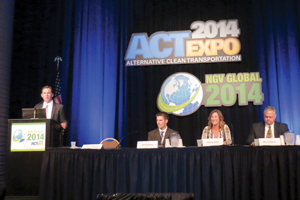Natural Gas Gaining Amid Fuel Options, Panelists Say at Clean Transport Expo

This story appears in the May 19 print edition of Transport Topics. Click here to subscribe today.
LONG BEACH, Calif. — Speakers at the Alternative Clean Transportation Expo here earlier this month noted challenges and opportunities as heavy-truck operations roll natural gas into their fuel mix, albeit slowly.
Truckload carrier Paper Transport Inc. has used compressed natural gas in its trucks since 2010 and has about 100 Kenworth vehicles, or about 25% of its fleet, running on the alternative fuel, company President Jeff Shefchik said.
“The No. 1 reason we’re using natural gas is economics,” said Shefchik, who spoke on a panel addressing CNG and liquefied natural gas.
LNG can sometimes “boil off,” or evaporate in a tank while not in use, as it must be at minus-260 degrees Fahrenheit to remain liquid, he noted.
“That’s fuel that is never going into an engine or moving a truck a mile,” Shefchik said, adding that CNG has less range than a standard diesel truck — 600 miles versus about 1,450.
And while CNG has about a 1,000-pound weight disadvantage versus LNG — its various tank configurations are heavier — it has about a 58-cents-per-gallon cost advantage over LNG, including an 18-cent tax advantage.
But one major grocery chain made the call to go with LNG, in part because use of LNG allowed its trucks a tighter turning radius that its drivers need in their operations.
Kroger Co. has a 1,200-tractor fleet and uses an additional1,800 third-party carriers for its 2,700 stores and 34 distribution centers, said Ashley White, Kroger’s manager of logistics sustainability.
Kroger announced during the ACT Expo that it had signed an LNG fueling contract with Clean Energy Fuels Corp. in the Portland, Oregon, area.
After running multiple checklists — White developed a study analyzing various configurations of fueling options — it chose Freightliner Cascadias with an adjusted exhaust system. White said they allowed its drivers to have improved sightlines.
The greater weight allowance in LNG added up to a pallet of goods per truck, which meant big money for the grocery chain. “We are extremely weight-sensitive,” White said, adding that the LNG system’s 350-mile runs fit well with the system, as some of its union drivers were not able to fill LNG, which requires special pump handling.
Saddle Creek Transportation has about 100 Freightliner CNG trucks in its fleet along with 350 diesel trucks, and the carrier’s president, Mike DelBovo, said that while CNG tank costs run higher, “thankfully, capital is cheap.”
Freightliner showed a Saddle Creek truck at its ACT Expo booth, and its aerodynamic setup with CNG tanks lined up behind the cab helps reduce drag, said Brian Daniels, Freightliner’s product manager for vocational and alternative fuels.
DelBovo said his company is putting about 110,000 miles a year on the trucks, which can run from 500 to 800 miles per fuel-up.
Saddle Creek’s natural-gas trucks have totaled 21 million miles to date, and DelBovo said his drivers carry “CNG kits” onboard, including special oil, in case they need to make a service stop.
Mike O’Connell, Frito-Lay North America’s senior director of fleet operations, said his company’s goal was to reduce fuel consumption by 50% and that it will “achieve a 20% reduction this year over the past few years.”
The PepsiCo unit — which has about 22,000 U.S. vehicles and 76,000 worldwide — started with 18 CNG units a few years ago, and today about “90% of its replacement units are natural gas,” O’Connell said at a plenary session.
Owens Corning, which makes fiberglass and building materials, moved about 250,000 truckloads last year, and about 10% of the 140 million miles its trucks have run this year have been via natural gas, said Dave Uncapher, head of sourcing and logistics operations.
The company is targeting to boost that to 50% by 2018, Uncapher told Transport Topics after a shippers’ session.
“With every carrier that comes to my office, before they leave we talk about natural gas,” he said. “The fueling infrastructure is driven by the shipper-carrier partnership to provide it where it’s most economical. It’s the shipper pushing the carriers, because carriers have to see the threat of a loss or gain to make an investment.”
John Sheehy, president of Sheehy Mail Contractors, which contracts with the U.S. Postal Service, said that after meeting with the U.S. Postmaster General in 2012 to outline its alternative-fuel plans, his company began rolling in Freightliner CNG tractors last year.
His CNG trucks have run “a little over a million miles,” Sheehy said. “In the short run, I think we need to buck up a little to get the [fueling] infrastructure in place. We need to be looking at three to four years down the road.”

